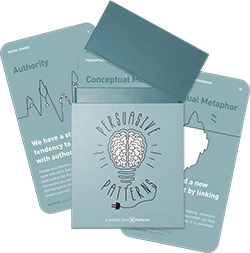Tailoring
Design Pattern
Problem summary
Adapt the offerings of a system to match individual users’ needs and abilities
Usage
This card is part of the Persuasive Patterns printed card deck
The Persuasive Patterns Card Deck is a collection of 60 design patterns driven by psychology, presented in a manner easily referenced and used as a brainstorming tool.
Get your deck!Solution
Tailor information to users individually. Content will be more persuasive if it is tailored to the individual needs, interests, personality, or usage context.
- Boost credibility. Tailoring the user experience has been proven to lead to increased perception of credibility. A website is seen as more credible when it acknowledges that an individual has visited before.
- Personally tailor information in real time. Provide information that matches the personal needs, interests, personality, or goals of the user. The more relevant the message is to the individual the higher persuasive power it will have.
- Tailor for the context. The more you can utilize the context and intention of the individual, the more relevant your message can be to not only the person, but also the context.
Rationale
Tailored information is more effective in changing attitudes and beliefs than generic information. Make life simpler for users by showing only what is relevant to them. Tailor to individual needs, interests, personality, usage context, or other factors relevant to the individual.
Users are persuaded either through a central route, with full cognitive attention, or through a peripheral route, relying on heuristics
Discussion
Cultural differences
Rilla Khaled has defined eight culturally-relevant persuasive technology strategies:
Harmony strategy
Cue social density to users, and thus subtly promote harmonious actions that support the group’s goals.
Group Opinion strategy
Provide users with the opinions of users similar to them at moments when users must make important decisions.
Having established the Captology Lab at Stanford (renamed to Behavior Design Lab), BJ Fogg was among the first to research persuasive technologies. Although somewhat ignored his book on Persuasion kicked off a new field of research and continues to grow in importance. Tailoring was among the core persuasive strategies BJ Fogg discovered.
1 Amanda Shiga, Persuasion and Information Architecture
2 Rilla Khaled et. al., A Qualitative Study of Culture and Persuasion in a Smoking Cessation Game, Proceedings of the 3rd international conference on Persuasive Technology
3 B. J. Fogg, Persuasive Technology, 2003
User Interface Design Patterns
- Forms
- Explaining the process
- Community driven
- Tabs
- Jumping in hierarchy
- Menus
- Content
- Gestures
- Tables
- Formatting data
- Images
- Search
- Reputation
- Social interactions
- Shopping
- Increasing frequency
- Guidance
- Registration
Persuasive Design Patterns
- Loss Aversion
- Other cognitive biases
- Scarcity
- Gameplay design
- Fundamentals of rewards
- Gameplay rewards


